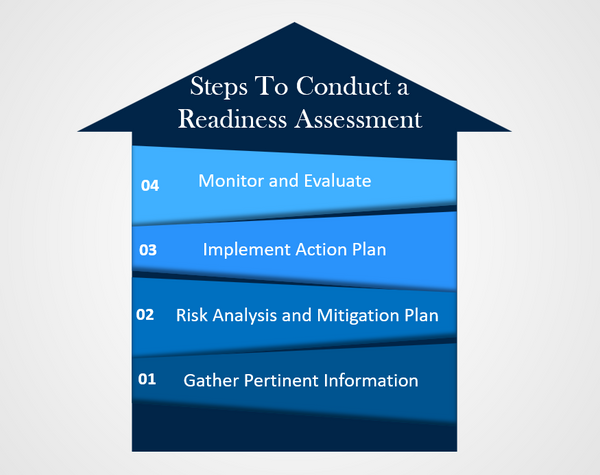GDPR Readiness Assessment Template
Overview
A readiness assessment is a comprehensive evaluation of an organization's preparedness to implement a new system, process, or strategy. The assessment helps identify gaps in the organization's resources, capabilities, and infrastructure that may hinder the successful implementation of the initiative.

What is Readiness Assessment?
A readiness assessment is an invaluable tool in preparing an organization’s systems and processes to meet the terms of the General Data Protection Regulation (GDPR). The GDPR is an EU regulation that updates the existing data protection laws with a comprehensive set of legal steps organizations must take to achieve compliance.
To help organizations understand their GDPR compliance needs, a readiness assessment can provide the necessary assessment and recommendations for ensuring privacy and data security.
A readiness assessment can assist an organisation in identifying areas for improvement, developing a plan to address any gaps, and ensuring that it is well-positioned to successfully implement the initiative.
An organisation can improve its chances of success, lower its risk of failure, and ensure that the initiative meets its goals and objectives by conducting a readiness assessment.
Importance Of Readiness Assessment
There are several important reasons why a readiness assessment is crucial for organizations planning to implement a new system, process, or strategy. Some of these reasons include:
1. Identify Potential Roadblocks: A readiness assessment assists in identifying potential roadblocks that may impede the initiative's successful implementation. This includes identifying resource, capability, and infrastructure gaps, as well as any cultural or organisational barriers that may impede progress.
2. Improve Chances of Success: By identifying potential roadblocks early on, an organization can develop a plan to address any gaps and improve the chances of success. This can help to ensure that the initiative is implemented effectively and efficiently, leading to improved outcomes and results.
3. Reduce Failure Risk: A readiness assessment can help to reduce failure risk by identifying potential challenges and addressing them before they become major roadblocks. This can help to reduce the potential impact of any issues and keep the initiative on track.
4. Save Time and Resources: A readiness assessment can help an organisation save time and resources by identifying potential issues before they become major issues. This can help to avoid costly delays, rework, and other issues that can arise when putting in place a new system, process, or strategy.
Overall, a readiness assessment is an important tool for organizations to assess their preparedness for implementing a new initiative.
How To Effectively Conduct a Readiness Assessment?
The main goal of a Readiness Assessment is to identify and analyze the potential areas of risk that can arise during the implementation of the project and to develop strategies to address those risks before they lead to delays or other problems.
A Readiness Assessment begins with a review of the project's requirements and objectives and then identifies the project's potential areas of risk.
Steps to conduct a Readiness Assessment are:

1. Gather Pertinent Information: The first step is to gather pertinent information. This includes gathering feedback from stakeholders, such as leaders and users, and project teams. Project teams should also gather data to measure the current level of readiness for the project and understand the overall risks associated with the project.
2. Risk Analysis and Mitigation Plan: During the risk analysis, project teams should identify and analyze all potential risks to the project. This should include both internal and external risks. Once all the risks are identified, the project team should prepare a mitigation plan outlining steps to address each identified risk.
3. Implement Action Plan: Implement action plans to mitigate the identified risks. These plans should be developed to address the identified risks while still meeting the project's goals. This includes steps such as increasing communication with stakeholders, getting buy-in from leaders, and training users.
4. Monitor and Evaluate: Monitor and evaluate the progress of the project. This includes monitoring the progress of the risk-mitigation plans and evaluating the project against key performance indicators. Adjustments to the project can be made based on the results of the assessment.
By following these steps, an organization can conduct a comprehensive readiness assessment that identifies potential roadblocks and develops an action plan to ensure the successful implementation of the initiative.
Benefits of Readiness Assessment
There are many benefits of readiness assessment, but some of the most important are listed below:
- Helps determine if an organization is ready for change.
- Helps identify gaps in an organization's current state.
- Provides recommendations on how to close those gaps.
- Helps create a shared understanding of the desired change.
- Helps create buy-in and commitment from key stakeholders.
- Helps ensure that the right people are in the right roles.
- Helps ensure that processes are aligned with the desired change.
Conclusion
A readiness assessment is an important process for organisations that are planning to implement a new system, process, or strategy because it identifies potential roadblocks and ensures that the organisation is well-prepared for the implementation.
By conducting a comprehensive readiness assessment, an organization can increase the chances of success, minimize the risk of failure, and improve efficiency and effectiveness.




